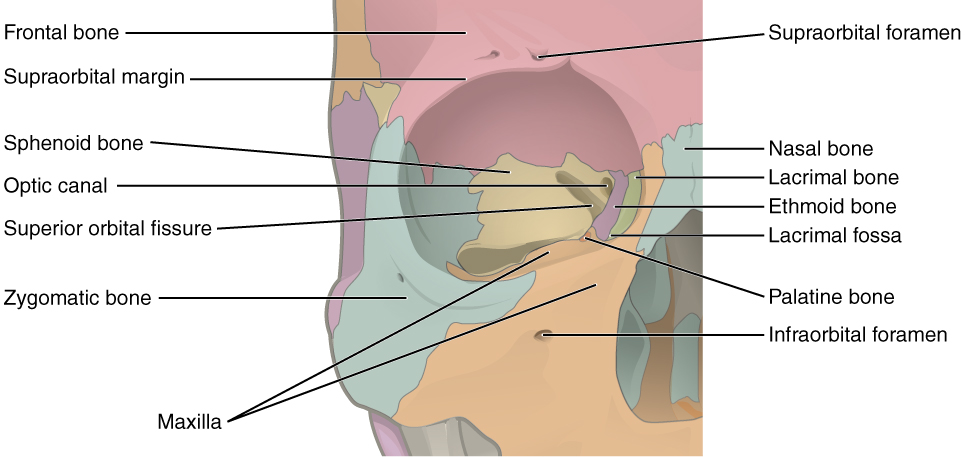Bones of the orbit and some of the major landmarks.
Image from candelalearning.com
There are 7 bones that comprise the orbit. It is our job as ophthalmologists to be able to readily identify these bones and know pretty much every bump, notch, hole, and contour of these bones and what structures pass through, travel along, and attach to these bones.
The bones are:
- Sphenoid
- Ethmoid
- Lacrimal
- Frontal
- Palatine
- Maxillary
- Zygomatic
Tips
Orbital bones.
Image from AccessLange: General Ophthalmology. Available online from Oculist.
There are many ways to remember these bones. Rote memorization isn't too bad with this list, since there are only 7 bones. For some more visually-oriented people, it's helpful to learn by memorizing their locations after staring at diagrams (which is why I'm scouring the Internet for pictures that can be helpful).
Right bony orbit.
Image from imagekb.com, courtesy of Google Images.
Right bony orbit.
Image from Medscape, courtesy Google Images.
Still others may prefer using a mnemonic. Tamesis' Ophthalmology Board Review book offers a few suggestions for mnemonics - for example, SELF PaM-Z for all of the bones of the orbit (1):
- Sphenoid
- Ethmoid
- Lacrimal
- Frontal
- Palatine
- Maxillary
- Zygomatic
Radiology
One of the things I wish I had studied more during residency was reading neuroimaging. Obviously, we get some training in this during medical school, and depending on the rotations and electives available to us, we may or may not have received more in-depth/formal training. However, I think that most of us, unless we specifically sought out additional resources, probably would be less comfortable reading a CT or MRI than we would otherwise like to be.
While a quick Google Image search shows tons of CT scans available on the Internet to view, precious few have labels or descriptions to help determine what structure is what. However, I think here are two excellent starting resources:
- Dutton JJ. Radiology of the Orbit and Visual Pathways. China: Saunders-Elsevier, 2010. Available on Amazon. Approximate price: $205.
For those people who want to have a good reference book for ophthalmology-related radiology, well-published orbital surgeon Dr. Jonathan Dutton has compiled a very detailed atlas of radiographic images of the orbit and visual pathways. Each image is painstakingly labeled, and captions and descriptions complete the review of normal anatomical structures as well as clinical examples of some of the most common (and not-so-common) orbital and neuro-ophthalmic diseases. Each residency program should probably have one of these in their library as a quick reference, and for the budding orbital surgeons and neuro-ophthalmologists out there, this may be must-have resource.
- w-radiology.com: CT of the orbital anatomy
Honestly, I just stumbled upon this Swiss-based website as I was Googling for radiology images I could use for this post. Unfortunately, copyright limitations prevent me from reproducing the images directly on this site (without expressed written permission, which I have not gotten). However, I can link you to this site, which has tons of images that are labeled and may be a nice FREE option for those who don't have a clinical education fund to use for textbooks. Thanks to Google Translate, everything can be easily translated into mostly-understandable English. It's definitely worth checking out, and may be helpful for translating the pretty illustrations into a more clinically-directed setting of trying to read a CT scan.
References and Additional Reading
- Tamesis R, ed. Ophthalmology Board Review: Pearls of Wisdom, 2nd ed. McGraw-Hill, 2005.
- Bones of the Orbit. Mission For Vision. Website.
Do you have any tips on how to remember the bony orbit? Leave a comment!




